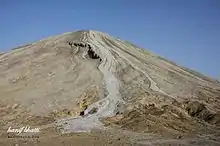Hingol mud volcanoes
The Hingol mud volcanoes (Balochi: ھنگول ئےِ خاک شان) (Urdu: ہنگول مٹی کے آتش فشاں) are located in Lasbela District, Balochistan, Pakistan at a distance of around 100 km from Uthal, which is the headquarter of District Lasbela. The mud volcanoes are located in Hingol National Park which is the largest national park in Pakistan.[1] It contains about ten clusters of mud volcanoes, the most important of which are Chandragup and Khandewari volcanoes.[2]
| Baba Chandrakup چندرگپ चन्द्रगुप | |
|---|---|
 Baba Chandrakup | |
| Religion | |
| Affiliation | Hinduism |
| District | Lasbela District |
| Deity | Baba Chandrakup (Lord Shiva) |
| Festivals | Four Day Theerth Yatra in April(Hinglaj Yatra) |
| Location | |
| Location | Hinglaj |
| State | Balochistan |
| Country | Pakistan |
 Location within Pakistan's Balochistan province. | |
| Geographic coordinates | 25°26′43″N 65°51′56″E |
| Elevation | 100 m (328 ft) |
| Website | |
| www | |
These are not located on the main road about a kilometer off the Makran Coastal Highway leading from Lasbela to Gwadar; the locals may provide guidance to the exact location. A landmark is a SSGC installation. The site is a complex of three major mud volcanoes and a number of smaller ones.
The three mud volcanoes of the location are named as Chandragup1, Chandragup2 and Chandragup3.[3] One of which is a 300-foot-high mud volcano. It is a sacred annual pilgrimage site for Hindus, along with the closeby Hinglaj Mata mandir.[1][4][5] Also known as Chandrakup, the volcano is considered holy by Hindus and is an important stop for pilgrims on their way to the Hinglaj Mata temple.[6] Devotees throw coconuts into the craters to make wishes and thank the gods for answering their prayers.[7]
Chandragup
Chandragup is an active mud volcano located in Hingol National Park in Balochistan, Pakistan.[8] Also known as Chandrakup, the volcano is considered holy by Hindus and is an important stop for pilgrims on their way to the shrine of Shri Hinglaj Mata temple.[6]
The Chandragup mud volcano is worshipped as an embodiment of the Hindu god Shiva, and called Baba Chandragup. Pilgrims to the volcano believe that the Shri Hinglaj Mata temple may only be entered only after paying homage to Baba Chandrakup. Traditionally, the pilgrim stays awake all night, fasting and meditating on the sins they will confess at the rim the following day. They bake roti made out of ingredients contributed by all the yātrīs. On the next day they ascend the slope of Chandrakup, and the roṭi is served as an offering to Baba Chandrakup. Nowadays, coconuts, betel nut and dal are also offered. At the volcano's peak, the pilgrims must introduce themselves with their full name and place of origin and then call out their sins in front of the group. According to the bubbling of the mud and the reaction of the wind, the chaṛīdār is able to tell if the pilgrim's sins are forgiven.[9]
Devotees throw coconuts into the craters to make wishes and thank the gods for answering their prayers.[10]
Gallery
 The view of Chandragup I mud volcano
The view of Chandragup I mud volcano Mud Volcano 1
Mud Volcano 1 Mud Volcano 2
Mud Volcano 2 Mud Volcano 3
Mud Volcano 3
References
- "Pakistan's Most Wild and Beautiful Places". National Geographic. 5 April 2018. Retrieved 22 August 2018.
- "Hingol Cultural Landscape". UNESCO World Heritage Centre.
- V. Santiago-Fandino, H. Tanaka, M. Spiske (14 April 2016). Tsunamis and Earthquakes in Coastal Environments: Significance and Restoration. Springer. ISBN 9783319285283.
{{cite book}}: CS1 maint: multiple names: authors list (link) - Xafar, Ali (20 April 2016). "Mata Hinglaj Yatra: To Hingol, a pilgrimage to reincarnation". Express Tribune.
- Mulki, Muhammad Adil (24 February 2013). "Footprints in the mud". Express Tribune.
- Mud Volcanoes of Balochistan Archived 2012-09-15 at the Wayback Machine, Owais Mughal, 2 March 2007, All Things Pakistan, Accessed: 25 September 2012, ... Very close to Chandargup is an ancient Hindu temple called ‘Hinglaj temple’ or ‘Nani Temple’. There are many pronunciations of the word Chandragup in practise. Due to close proximity a Hindu temple to these volcanoes, it is very likely that the word Chandargup is actually derived from the word ‘Chandargupt’. Another word which locally mentions this group of volcanoes is ‘Chandra coop’ which means Volcanoes of the Moon ... The Hindus worship these mud volcanoes as the habitation of a deity Babhaknath ...
- "Hindu Pilgrimage in Pakistan". National Geographic Society. 10 January 2019.
- Muddy Coasts of the World: Processes, Deposits, and Function, pp. 149, Gulf Professional Publishing, 2002, ISBN 9780444510198, ... The Las Bela Coastal Plain in Baluchistan is also renowned for the occurrence of mud volcanoes (Snead 1964). The largest one of these, the Chandragup, forms an almost perfect cone 58 m high ...
- http://40.114.28.106/PDF/5322-pdf-VNV/p2/9780190850531.PDF
- "Hindu Pilgrimage in Pakistan". National Geographic Society. 10 January 2019.